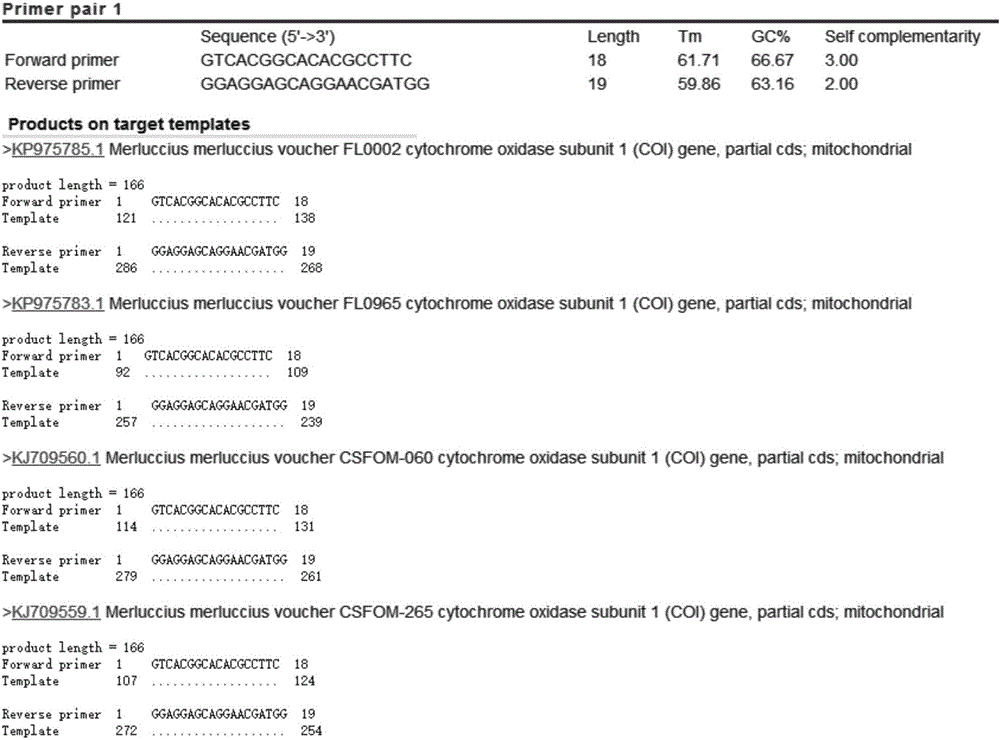Real-time fluorescence PCR specific detection system and applications of Merluccius Merluccius
A real-time fluorescent and specific technology, which is applied in the determination/inspection of microorganisms, DNA/RNA fragments, recombinant DNA technology, etc. The effect of high detection sensitivity
- Summary
- Abstract
- Description
- Claims
- Application Information
AI Technical Summary
Problems solved by technology
Method used
Image
Examples
Embodiment 1
[0025] The design of embodiment 1 fluorescent PCR specific detection primer sequence
[0026] 1. Analysis of the CoⅠ gene of the relative species of hake
[0027] Log in to NCBI (http: / / www.ncbi.nlm.nih.g) The N program searches for similar sequences in the nr database, and the species distribution of the returned similar sequences is as follows figure 1 shown, and searched all the sequences in the nr database using Merluccius Merluccius and CoI as keywords, downloaded and saved the sequences of the search results, and then downloaded and saved the Blast sequence. figure 1 is the species distribution of similar sequences, where the species in the box is the location of hake.
[0028] 2. Design of Hake Species-Specific Detection Primers
[0029] The downloaded sequence is subjected to sequence similarity analysis and sequence analysis, and specific primers are designed for sequence differences.
[0030] 3. Specificity analysis of hake species-specific detection primers
[0...
Embodiment 2
[0044] Embodiment 2 Application of real-time fluorescent PCR specific detection system
[0045]The application of the real-time fluorescent PCR specific detection system for hake species is to use the real-time fluorescent PCR specific detection system for hake species to amplify the CoI gene of hake species, and perform real-time fluorescent PCR specific detection for hake species. The specific steps are as follows :
[0046] Table 3 The reaction system of the real-time fluorescent PCR specific detection system for hake species
[0047]
[0048] The reaction parameters of the real-time fluorescent PCR specific detection system for hake species are as follows in Table 4:
[0049] Table 4 Reaction parameters of the real-time fluorescent PCR specific detection system for hake species
[0050]
[0051] When the CoI gene of hake is amplified by real-time fluorescent PCR using the real-time fluorescent PCR specific detection composition of hake species, the Premix Ex Taq ...
Embodiment 3
[0052] Embodiment 3 specific detection
[0053] Utilize the real-time fluorescent PCR specific detection system for hake species to perform real-time fluorescent PCR specific detection of hake species components of hake and other cod samples, use a DNA extraction kit to extract the template DNA of each sample to be tested, and use microspectrometry The concentration of the extracted template DNA was detected by a photometer to be 50 ng / μL, and PCR amplification was carried out according to the reaction system and reaction parameters described in the above step 4, and the specific amplification curve generated below 30 cycles was hake , other samples showed amplification curves or no amplification curves after 30 cycles. This method can accurately identify the components of hake and has good specificity, such as Figure 5 shown.
PUM
 Login to View More
Login to View More Abstract
Description
Claims
Application Information
 Login to View More
Login to View More - R&D
- Intellectual Property
- Life Sciences
- Materials
- Tech Scout
- Unparalleled Data Quality
- Higher Quality Content
- 60% Fewer Hallucinations
Browse by: Latest US Patents, China's latest patents, Technical Efficacy Thesaurus, Application Domain, Technology Topic, Popular Technical Reports.
© 2025 PatSnap. All rights reserved.Legal|Privacy policy|Modern Slavery Act Transparency Statement|Sitemap|About US| Contact US: help@patsnap.com



